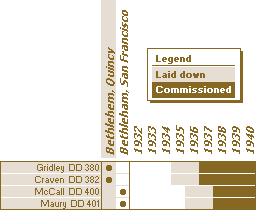

The Gridleys retained the basic hull of the Mahan class but featured a single stack and were fitted with a pole mast from the beginning. Also, they, the Bagleys and the Benhams mounted 16 torpedo tubes, the heaviest battery ever among American destroyers, reflecting an increased emphasis on torpedo tactics in vogue at the time they were designed. They carried these in four quadruple mounts—two on each side of the weather deck, fitted abaft the stack—but to do so, they sacrificed the midships 5-inch gun of the Mahan and Farragut classes, leaving a total of only four.
Length: 340' 10-7/16" overall; 333 10-1/2' design waterline.1
Beam: 35' 0-1/4" molded maximum; 35' 6-1/4" outside of plating at design waterline.1
Freeboard: 21 4" at bow; 10' 6-5/8" at stern.1
Displacement: 1,500 long tons design; 1,725 long tons to design waterline.1
Draft: 11' 5-1/2" mean; 13' 2-1/4" full load.3
Propulsion machinery: 4 x Bethlehem boilers; 618 psi, 645° F.; Bethlehem geared turbines; 50,000 shp; 2 shafts.1
Designed speed: 36.5 knots.2
Fuel bunkerage: 524.93 tons full load (95% of capacity).1
Endurance: 7,800 nm at 12 knots.3
Designed complement: 13 officers; 193 enlisted.3
Torpedo battery: Sixteen 21-inch trainable torpedo tubes: two quadruple wing mounts on each side of the main deck abaft the stack.
Main gun battery: 4 x dual purpose 5-inch/38 caliber guns: 2 forward in enclosed base ring mounts; 2 aft in open pedestal mounts.
Anti-aircraft battery: 1938: 4 x .50 cal. machine guns; 1945: 6 x 20mm Oerlikon in single mounts.
What set the Gridley and Somers classes apart from preceding classes, however, was their advanced powerplant, with enlarged turbines operating not at 400 psi as in the Mahans and Porters, but at 565 psi—good for an increase to 50,000 shp and, in Maury’s case, good enough to achieve 42.8 knots during her acceptance trials, the highest ever recorded for an American destroyer.
Spacious and simple compared with the Mahans’ machinery, the new machinery design performed so satisfactorily that it was carried over to the Benham class and served as a basis for even more advanced designs in the classes to follow. Unfortunately, all these advances were incorporated on a hull of marginal strength and stability.
From their completion through mid-World War II, the four Gridleys formed Destroyer Division 11 of Destroyer Squadron 6—flagship Balch—with Dunlap, Benham, Fanning and Ellet rounding out the squadron as DesDiv 12. Based at Pearl Harbor in 1941, the squadron was at sea escorting Enterprise (CV 6) on 7 December, then was dispersed among carrier task forces during the Pacific island raids of early 1942. While Gridley and McCall were sent to the Aleutians in June, Maury was at Midway and then went to Guadalcanal, where she participated in the Battle of Tassafaronga in November. The four ships of the class were reunited as Saratoga’s screen for the New Georgia landings in June 1943; then Maury was with DesRon 12 at the Battle of Kolombangara in July, and with Craven for the Battle of Vella Gulf in August. Gridley and Maury were at the Gilbert Islands landing in November of that year. All four destroyers operated together in the Marshalls and Marianas campaigns through mid-1944, and, less Craven (which went to the Atlantic), continued screening escort carriers off the Philippines and Formosa into 1945.
The Gridleys’ stability and hull strength were concerns throughout their careers, however. Modifications could not be made without trade-offs, and even as danger grew from suicide air attack, they remained the only goldplaters in which the Navy never dared fit with 40mm Bofors due to the topweight penalty. In 1945, therefore, the three ships remaining in the Pacific were withdrawn. Maury, with a crack in her deck that was no longer deemed worth repairing, was decommissioned in October. McCall was overhauled at New York but then decommissioned in November. Gridley and Craven continued operating in the Atlantic and Mediterranean until after the war, but then returned to Pearl Harbor where they were decommissioned in 1946. All were scrapped by the end of 1948.
1 Bureau of Construction and Repair’s General Information book for USS Gridley and USS Craven; dimensions given for Gridley.
2 Bauer and Roberts.
3 Friedman.